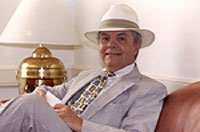 Early in 1917 World War I came to an end in Russia when that country withdrew in the face of Revolution at home. Czar Nicholas II abdicated, and for a short time Russia experimented with democracy. In March, 1917, a month before the U.S. entered the War, President Woodrow Wilson sent a committee of inquiry into Revolutionary Russia on a fact-finding mission. They recommended that several groups of observers and/or military be sent to monitor the situation. The first such party to go into Russia was a YMCA group that included Rev. John Logan Findlay, an 1897 graduate of WRA and an ordained Congregational minister. They arrived in St. Petersburg about the time that Alexander Kerensky became head of the Provisional Government, and apparently traveled along the front and deep into Siberia.
Early in 1917 World War I came to an end in Russia when that country withdrew in the face of Revolution at home. Czar Nicholas II abdicated, and for a short time Russia experimented with democracy. In March, 1917, a month before the U.S. entered the War, President Woodrow Wilson sent a committee of inquiry into Revolutionary Russia on a fact-finding mission. They recommended that several groups of observers and/or military be sent to monitor the situation. The first such party to go into Russia was a YMCA group that included Rev. John Logan Findlay, an 1897 graduate of WRA and an ordained Congregational minister. They arrived in St. Petersburg about the time that Alexander Kerensky became head of the Provisional Government, and apparently traveled along the front and deep into Siberia.At some point the party met Grand Duchess Tatiana, the second oldest daughter of Nicholas II,
 probably at Tsarkoe Selo, the palace the Romanov family occupied following the abdication which was about 15 miles outside St. Petersburg. Findlay later recalled that "her case was pitiful, for she had no conception of the seriousness of her country's predicament. She believed her father would be restored to the throne." Findlay claimed he was given some "gold cups, silver dishes, jewel-studded bowls, opera glasses" and other artifacts which he brought back home. The YMCA party continued their journey until after Lenin came to power, and early in 1918 they were forced to flee across Siberia in a desperate journey that took 34 days, and then continued by ship to Japan. Upon his return to the U.S., Findlay, along with Sir George Adam Smith of Aberdeen University who had shared his ordeal, went on a speaking tour throughout the South and West. Eventually, Findlay returned to Hudson as Pastor of the First Congregational Church from 1926 to 1930, and his son, Myron, graduated from WRA in 1931.
probably at Tsarkoe Selo, the palace the Romanov family occupied following the abdication which was about 15 miles outside St. Petersburg. Findlay later recalled that "her case was pitiful, for she had no conception of the seriousness of her country's predicament. She believed her father would be restored to the throne." Findlay claimed he was given some "gold cups, silver dishes, jewel-studded bowls, opera glasses" and other artifacts which he brought back home. The YMCA party continued their journey until after Lenin came to power, and early in 1918 they were forced to flee across Siberia in a desperate journey that took 34 days, and then continued by ship to Japan. Upon his return to the U.S., Findlay, along with Sir George Adam Smith of Aberdeen University who had shared his ordeal, went on a speaking tour throughout the South and West. Eventually, Findlay returned to Hudson as Pastor of the First Congregational Church from 1926 to 1930, and his son, Myron, graduated from WRA in 1931. John Logan Findlay subsequently went on to another pastorate in Taunton, Massachusetts, later retiring to Hyannis on Cape Cod where he died in 1959. An unusual photo of him in the Reserve Record in 1930 shows him wearing a Soviet uniform in five poses done with the aid of mirrors. What became of the artifacts he reportedly had been given by the Romanovs remains a mystery. Grand Duchess Tatiana was murdered by the Bolsheviks along with the other members of the Romanov family in July,1918. In recent years, their remains were interred at a cathedral in St. Petersburg and they have all been acclaimed as saints and martyrs by the Russian Orthodox Church.
John Logan Findlay subsequently went on to another pastorate in Taunton, Massachusetts, later retiring to Hyannis on Cape Cod where he died in 1959. An unusual photo of him in the Reserve Record in 1930 shows him wearing a Soviet uniform in five poses done with the aid of mirrors. What became of the artifacts he reportedly had been given by the Romanovs remains a mystery. Grand Duchess Tatiana was murdered by the Bolsheviks along with the other members of the Romanov family in July,1918. In recent years, their remains were interred at a cathedral in St. Petersburg and they have all been acclaimed as saints and martyrs by the Russian Orthodox Church.
